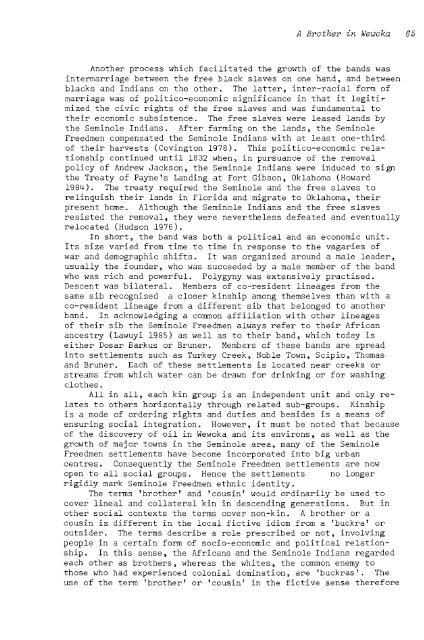CONTENTS NO.I - Institute of Social and Cultural Anthropology ...
CONTENTS NO.I - Institute of Social and Cultural Anthropology ...
CONTENTS NO.I - Institute of Social and Cultural Anthropology ...
You also want an ePaper? Increase the reach of your titles
YUMPU automatically turns print PDFs into web optimized ePapers that Google loves.
A Brother in Wewoka 65<br />
Another process which facilitated the growth <strong>of</strong> the b<strong>and</strong>s was<br />
intermarriage between the free black slaves on one h<strong>and</strong>, <strong>and</strong> between<br />
blacks <strong>and</strong> Indians on the other. The latter, inter-racial form <strong>of</strong><br />
was <strong>of</strong> politico-economic<br />
in that it legitir<br />
mized the civic rights <strong>of</strong> the free slaves <strong>and</strong> was fundamental to<br />
their economic subsistence. The free slaves were leased l<strong>and</strong>s by<br />
the Seminole Indians. After farming on the l<strong>and</strong>s, the Seminole<br />
Freedmen compensated the Seminole Indians with at least one-third<br />
<strong>of</strong> their harvests (Covington 1978). This politico-economic relacontinued<br />
until 1832 when, in pursuance <strong>of</strong> the removal<br />
<strong>of</strong> Andrew Jackson, the Seminole Indians were induced to sign<br />
the Treaty <strong>of</strong> Payne's L<strong>and</strong>ing at Fort Gibson, Oklahoma (Howard<br />
1984). The treaty required the Seminole <strong>and</strong> the free slaves to<br />
their l<strong>and</strong>s in Florida <strong>and</strong> to Oklahoma, their<br />
present home. Although the Seminole Indians <strong>and</strong> the free slaves<br />
resisted the removal, they were nevertheless defeated <strong>and</strong> eventually<br />
relocated (Hudson 1976).<br />
In short, the b<strong>and</strong> was both a political <strong>and</strong> an economic unit.<br />
Its size varied from time to time in response to the v{:3.garies <strong>of</strong><br />
war <strong>and</strong> demographic shifts. It was organized around a male leader,<br />
the founder, who was succeeded by a male member <strong>of</strong> the b<strong>and</strong><br />
who was rich <strong>and</strong> powerful. Polygyny was<br />
Descent was bilateral. Members <strong>of</strong> co-resident<br />
same sib recognized a closer kinship among themselves<br />
co-resident lineage from a different sib that to another<br />
b<strong>and</strong>. In acknowledging a common affiliation with other lineages<br />
<strong>of</strong> their sib the Seminole Freedmen always refer to their African<br />
ancestry (Lawuyi 1985) as well as to their b<strong>and</strong>, which is<br />
either Dosar Barkus or Bruner. Members <strong>of</strong> these b<strong>and</strong>s<br />
into settlements such as Turkey Creek, Noble Town, , Thomas<br />
<strong>and</strong> Bruner. Each <strong>of</strong> these settlements is located near creeks or<br />
streams from which water can be drawn for drinking or for<br />
clothes.<br />
All in all, each kin group is an independent unit <strong>and</strong> only relates<br />
to others horizontally through related sub-groups. Kinship<br />
rights <strong>and</strong> duties <strong>and</strong> besides is a,means <strong>of</strong><br />
However, it must be noted that because<br />
oil in Wewoka <strong>and</strong> its environs, as well as the<br />
growth<br />
towns in the Seminole area, many <strong>of</strong> the Seminole<br />
Freedmen settlements have become incorporated into big urban<br />
centres.<br />
the Seminole Freedmen settlements are now<br />
open to all groups. Hence the settlements no longer<br />
rigidly mark Seminole Freedmen ethnic identity.<br />
The terms 'brother' <strong>and</strong> 'cousin' would ordinarily be used to<br />
cover lineal <strong>and</strong> collateral kin in descending generations. But in<br />
other social contexts the terms cover non-kin. A brother or a<br />
cousin is different in the local fictive idiom from a 'buckra' or<br />
outsider. The terms describe a role prescribed or not, involving<br />
people in a certain form <strong>of</strong> socio-economic <strong>and</strong> political relationship.<br />
In this sense, the Africans <strong>and</strong> the Seminole Indians regarded<br />
each other as brothers, whereas the whites, the common enemy to<br />
those who had<br />
colonial domination, are 'buckras'. The<br />
use <strong>of</strong> the term 'brother' or 'cousin' in the fictive sense therefore

















